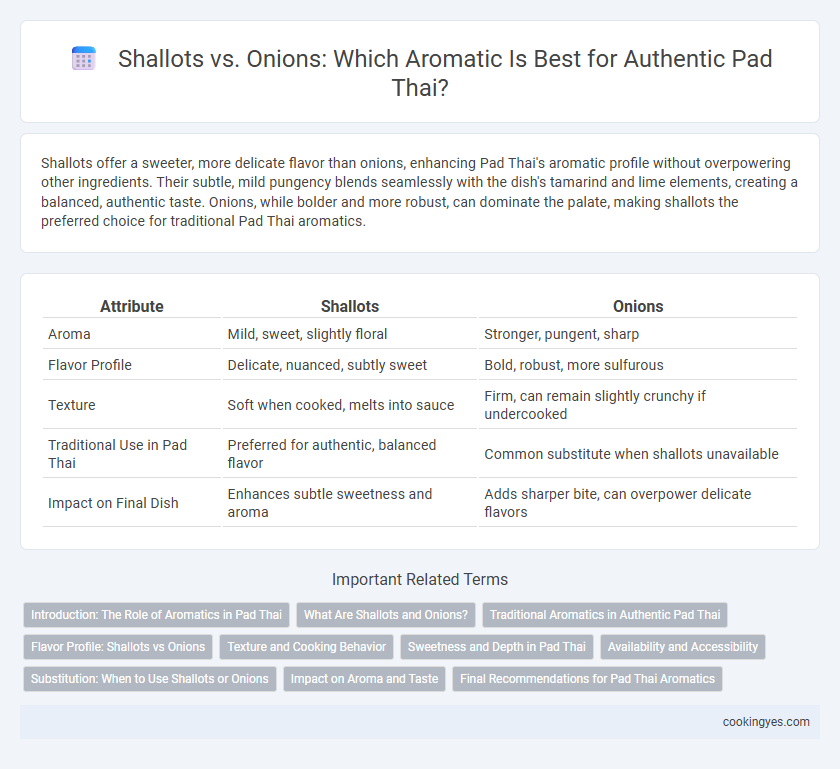Shallots offer a sweeter, more delicate flavor than onions, enhancing Pad Thai's aromatic profile without overpowering other ingredients. Their subtle, mild pungency blends seamlessly with the dish's tamarind and lime elements, creating a balanced, authentic taste. Onions, while bolder and more robust, can dominate the palate, making shallots the preferred choice for traditional Pad Thai aromatics.
Table of Comparison
| Attribute | Shallots | Onions |
|---|---|---|
| Aroma | Mild, sweet, slightly floral | Stronger, pungent, sharp |
| Flavor Profile | Delicate, nuanced, subtly sweet | Bold, robust, more sulfurous |
| Texture | Soft when cooked, melts into sauce | Firm, can remain slightly crunchy if undercooked |
| Traditional Use in Pad Thai | Preferred for authentic, balanced flavor | Common substitute when shallots unavailable |
| Impact on Final Dish | Enhances subtle sweetness and aroma | Adds sharper bite, can overpower delicate flavors |
Introduction: The Role of Aromatics in Pad Thai
Shallots deliver a subtle sweetness and a delicate aroma that enhances the authentic flavor profile of Pad Thai, distinguishing it from the stronger, more pungent scent of onions. Their mild, slightly garlicky notes create a balanced base that blends seamlessly with tamarind, fish sauce, and lime, key ingredients in Pad Thai. Using shallots over onions preserves the traditional aromatic complexity essential for achieving the perfect savory-sweet harmony in this iconic Thai dish.
What Are Shallots and Onions?
Shallots are small, mild-flavored alliums with a subtle sweetness and a hint of garlic, often used in Southeast Asian cooking to enhance Pad Thai's aromatic profile. Onions are larger bulbs with a more pungent and sharp taste, commonly found in Western kitchens but can overpower the delicate balance of flavors in Pad Thai. Choosing shallots over onions preserves the dish's authentic aroma, blending seamlessly with tamarind, fish sauce, and toasted peanuts.
Traditional Aromatics in Authentic Pad Thai
Traditional Pad Thai relies on shallots for its authentic aromatic profile, offering a sweeter and more delicate flavor compared to onions. Shallots release a subtle fragrance when stir-fried, enhancing the dish's complex taste without overpowering the balance of tamarind and fish sauce. Using onions instead can introduce a sharper, more pungent aroma that diverges from the classic Pad Thai character favored in Thai street food.
Flavor Profile: Shallots vs Onions
Shallots provide a sweeter, more delicate flavor with subtle garlic and onion notes, enhancing Pad Thai's aromatic complexity without overpowering other ingredients. Onions have a sharper, more pungent profile that can dominate the dish's balance, making them less ideal for traditional Pad Thai recipes. Using shallots maintains the authentic taste and layered aroma essential to achieving the classic Pad Thai flavor profile.
Texture and Cooking Behavior
Shallots offer a delicate, slightly sweet flavor with a finer texture that caramelizes quickly in Pad Thai, enhancing the dish's subtle aromatic profile. Onions, with their coarser texture and stronger pungency, require longer cooking to soften and integrate flavors without overpowering the balance of ingredients. Choosing shallots preserves the traditional silkiness and nuanced sweetness characteristic of authentic Pad Thai aromatics.
Sweetness and Depth in Pad Thai
Shallots bring a delicate sweetness and subtle depth to Pad Thai, enhancing its signature balance of flavors without overpowering the dish. Onions, while offering a sharper, more robust taste, can sometimes dominate the aromatic profile, reducing the nuanced complexity Pad Thai relies on. Using shallots ensures a smoother sweetness and richer umami foundation, crucial for achieving authentic Pad Thai's layered flavor experience.
Availability and Accessibility
Shallots, prized for their mild sweetness and delicate aroma, are often preferred for authentic Pad Thai but may be less accessible in some regions compared to onions, which are more widely available and affordable. Onions provide a stronger, more pungent flavor that can alter the traditional taste profile of Pad Thai when substituted for shallots. Choosing between shallots and onions depends largely on regional availability and accessibility, influencing the dish's aromatic authenticity.
Substitution: When to Use Shallots or Onions
Shallots are preferred in Pad Thai for their delicate sweetness and subtle garlic flavor, which enhances the dish's authentic aroma. Onions can substitute shallots when shallots are unavailable, but their stronger pungency may alter the traditional balance of flavors. Use onions sparingly and finely chopped to mimic shallots' mildness, preserving the signature taste of Pad Thai.
Impact on Aroma and Taste
Shallots contribute a subtle sweetness and delicate floral aroma to Pad Thai, enhancing its complex flavor profile with mild pungency that blends seamlessly with tamarind and lime. Onions offer a sharper, more robust flavor, which can overpower the dish's balance, resulting in a less nuanced taste. Using shallots preserves the authentic aromatic character essential to traditional Pad Thai, elevating its signature sweet-savory harmony.
Final Recommendations for Pad Thai Aromatics
Shallots provide a sweeter, more delicate flavor that enhances the traditional aroma of Pad Thai, making them the preferred choice in authentic recipes. Onions offer a sharper, more pungent taste that can overpower the balance of herbs and spices, so they are best used sparingly if substituted. For optimal Pad Thai aromatics, finely sliced shallots ensure a balanced, fragrant base that complements the dish's characteristic sweet and savory profile.
Shallots vs onions for Pad Thai aromatics Infographic

 cookingyes.com
cookingyes.com